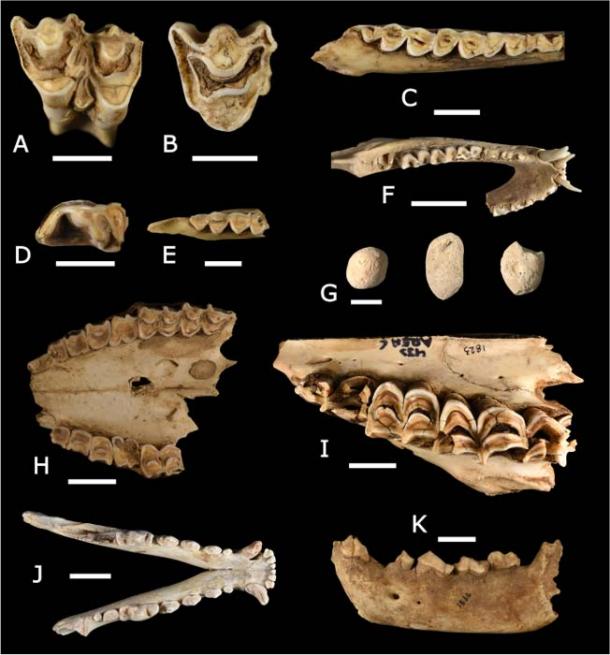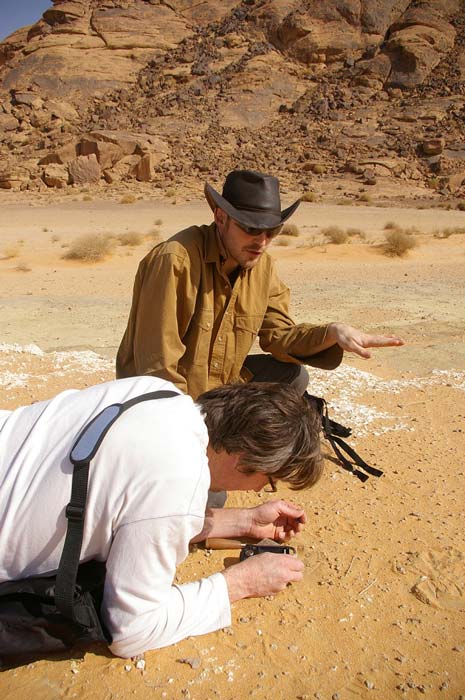
Hyena Cave in Saudi Arabia Yields Huge Pile of Animal and Human Bones
A team of international scientists searching inside a Saudi Arabian cave made by ancient lava flow found one of the most substantial collections of human and animal bones ever assembled. Deep inside a lava tube known as Umm Jirsan in northwest Saudi Arabia, they discovered tens of thousands of dried bones piled up and spread across sections of the cave floor. The bones were in surprisingly good condition, despite their clear antiquity. The cache included the bones of more than 40 animal species, such as horses, donkeys, wolves, foxes, sheep, camels, goats, gazelle, and hyenas. The human remains were the equivalent of the proverbial needle in a haystack, with just a few skullcaps found mixed in among this giant tumble of animal bones.
Radiocarbon dating has revealed some of the bones to be nearly 7,000 years old. Others are a lot younger, as it seems the bones were deposited inside the cave over the course of several millennia.

Images of Saudi Arabia’s Umm Jirsan “hyena cave”: A: Entrance to the western passage and surrounding area. B: Entrance to the western passage. Note the team members on the right-hand wall for scale. C: The back chamber in which the excavation was carried out. D: Plotted sampling square before surface collection and excavation. (Archaeological and Anthropological Sciences)
Understanding the Countless Bones Found In the “Hyena cave”
But how did this gigantic collection of bones end up in such a hidden location? Were they deposited there by groups of Holocene epoch hunter-gatherers, after they’d finished removing all the meat from the animals they’d killed?
Well actually, that is not what happened in this case. The scientists say these bones were dragged into the cave by a particular type of animal, one that survives primarily by scavenging.
- Ice Age Foxes Feasted On Our Reindeer Meat Leftovers
- Holocene Extinction, Anthropocene Extinction, or Merely the Dust in the Wind?
“The size and composition of the bone accumulation, as well as the presence of hyena skeletal remains and coprolites, suggest that the assemblage was primarily accumulated by striped hyena (Hyaena hyaena),” the scientists wrote in an article published in the August edition of the journal Archaeological and Anthropological Sciences.
They described the bone collection as the typical result of large-scale carnivore/scavenger activity. They identified the striped hyena as the most logical candidate based on its well-known habits and long presence in the region.
“Striped hyena are very avid accumulators of bones,” study co-author Mathew Stewart, a zooarchaeologist from the Max Planck Institute in Germany, told Gizmodo.

Simple plan of the Umm Jirsan lava tube system. Redrawn after Pint (2009). Survey by MA Al-Shanti, JJ Pint, and M Moheisen. Map by MA Al-Shanti and JJ Pint. (Archaeological and Anthropological Sciences)
The discovery of the pieces from human craniums supports this theory. Striped hyenas are known for digging up human graves to carry the bodies away, and they normally will consume everything they find except for the top of the skull.
Striped hyenas are a threatened species in modern-day Saudi Arabia. But several thousand years ago they were common on the Arabian Peninsula, roaming far and wide in search of food in the lava fields of what is now northwest Saudi Arabia. Like many scavengers, they were and are highly opportunistic. They are willing to consume the remains of just about any kind of animal, as the diversity of the species found in the Saudi Arabian cave demonstrates.
Even though the striped hyena is primarily a scavenger, it will hunt and kill its prey in some instances. There is no way to tell for sure how the humans whose skulls were discovered among the animal bones died, and the possibility that they were stalked and killed by ancient hyenas cannot be ruled out.

A–B Upper molars, Bos sp. (wild cow). C Right mandible, Gazella sp. cf. G. Dorcas (gazelle). D lower third premolar, Bos sp. E right mandible, Gazella sp. cf. G. dorcas. F Mandible, Procavia capensis (rock rabbit). G Coprolites, Hyaena. H Maxilla, Capra sp. (wild goat). I Right maxilla, Camelus sp. (camel). J Mandible, Canis lupus (wolf). K Left mandible, Hyaena. Scale bars 10 mm (A–G) and 30 mm (H–K). (Archaeological and Anthropological Sciences)
The Secrets of the Umm Jirsan Bone Cave Revealed
The Umm Jirsan lava tube was discovered in 2007. But growling sounds were heard coming from deep inside the cave, which suggested that hyenas may have been occupying it at that time.
It was only a few months ago that scientists affiliated with the Saudi Geological Survey, King Saud University, and the Max Planck Institute finally decided to investigate the depths of the cave. Their fearless efforts were rewarded, as multiple chambers in the western part of the cave were found to be littered with bones, none of which appear to have been left behind recently.
A total of 1,917 bones and teeth were separated from the bone collection and removed from the cave for further analysis. Looking at the bones more closely, the researchers found cut marks, bite marks, and digestions marks that helped verify the theory that the bones were harvested by striped hyenas.
“Forty-two percent of bone has evidence for carnivore processing, which includes gnaw marks, gastric etching, and rounding from licking. Gnaw marks take the form of tooth pits,” the study authors explained.
Working in groups, the hyenas would have dragged whole animals or parts of them into the cave for short-term storage and eventual consumption. When their food source was human, they would have eaten everything but the top area of the skull, which is a distinctive hyena practice.
“It’s always just the skullcap that survives” with striped hyenas, Stewart explained. “They seem to not really be interested in skull caps. We found maybe five or six skullcaps with gnaw marks on them at the site, but only the skullcaps. Nothing else.”
A small number of the bones were selected for radiocarbon dating. Results varied, with the oldest bones registering at 6,839 years old. None of these tests involved the human skullcaps, so no dates are currently associated with those remains.

Two researchers from the Paleodeserts Project examining a site in Saudi Arabia. The Project is a large-scale, multidisciplinary research initiative attempting to track the effects of environmental and climate change in the Arabian Desert region over the past one million years. (Paleodeserts)
The Paleodeserts Project Seeks Answers
The current investigations at the Umm Jirsan lava tube were undertaken under the sponsorship of the Paleodeserts Project. This large-scale, multidisciplinary research initiative is attempting to track the effects of environmental and climate change in the Arabian Desert region over the past one million years. Of particular interest is how environmental changes may have impacted the survival strategies and behaviors of the various animal and human species that occupied the area.
- Ritual Platform Discovered in Saudi Arabia, With Egyptian Artifacts
- Bir Hima Saudi Arabia Rock Art Site Gets UNESCO World Heritage Status
The latter goal is challenging. The current arid climate in the Saudi Arabian desert is hard on organic materials, including bones. If animal bones are exposed to the elements they can become dry and brittle and turn to dust, which explains why bones can be difficult to find in the region.
Fortunately, the indoor environment at the Umm Jirsan lava cave protected its contents from these elements. As a consequence, Paleodeserts Project personnel now have a golden opportunity to study a rare type of ancient remain, and study it in abundance.
The Umm Jirsan cave system features three lava-tube passages that measure nearly 5,000 feet (1,500 meters) in length from front to back. It is believed that the volcanic activity that produced Umm Jirsan likely created many other lava-tube caves in the same region of Saudi Arabia, although these other caves have yet to be found.
With the discovery of the huge bone cache at Umm Jirsan, Paleodeserts Project scientists will be actively searching for these unexplored caves, hoping that they, too, will produce valuable discoveries.
Some of these lava tubes may very well have been occupied by humans at different points in the past, raising the possibility that cultural artifacts might be found alongside any animal remains.
Top image: Inside the hyena cave of Umm Jirsan, one of the most spectacular lava tube caves in the world. Source: Kingdom of Saudi Arabia For UNESCO
By Nathan Falde














